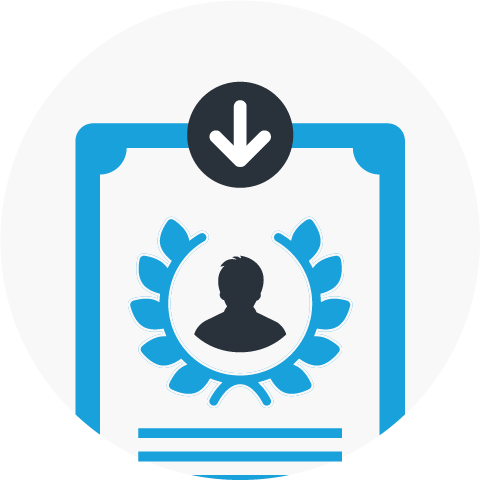Do you need help understanding how to gather performance evidence?
Well, you’ve come to the right place!
In this blog, you’ll find out what performance evidence is, how it relates to assessments, what types of assessment activities you can use to gather performance evidence and much more!
So, without further ado…
What is Performance Evidence?

Learners must be able to meet the learning outcomes outlined in their qualification to pass. To do this, they must meet certain criteria for those learning outcomes by undertaking and passing assessment activities. Some assessment activities require the assessor to gather knowledge evidence and/or performance evidence to pass.
The key difference between these two pieces of evidence is that knowledge evidence tests what a learner knows and performance evidence tests what a learner can do.
So, to test a learner’s knowledge, assessors can use assessment activities such as written assignments and MCQs (Multiple Choice Questions) to compile knowledge evidence. To test a learner’s ability, assessors can use activities such as observations, work product evidence and witness testimonies to compile performance evidence.
How Do I Know When to Gather Performance Evidence and When to Gather Knowledge Evidence?

You can find out what an assessment criteria requires by looking at the command verb in the learning outcome. Generally, learning outcomes with the command verb ‘understand’ will test a learner’s knowledge and will require knowledge evidence. Learning outcomes with the command verb ‘be able to’ will test a learner’s ability and will require performance evidence.
Let’s apply this to the learning outcomes for Unit 1 of the TQUK Level 2 Certificate in Retail Skills (RQF):

As you can see, the first learning outcome asks for the learner to ‘understand how to recognise bullying in the workplace’, which will test their knowledge and require knowledge evidence. The second learning outcome asks for the learner to ‘be able to work effectively in a retail team’, which will test their ability and require performance evidence.
However, as with every rule, there are exceptions. It is best practice to look at the command verb used in the individual assessment criteria which will tell you what you need to assess from the learner and how. So, for example, the assessment criteria 1.1 and 1.2 uses the command verb ‘explain’, which tests the learner’s knowledge as it asks them to explain certain concepts, and this will require knowledge evidence. In contrast, if you look at the command verbs used in the assessment criteria under learning outcome 2:
- Ask
- Respond
- Offer
- Identify
- Follow
These command verbs require the assessor to verify that the learner has the ability to carry out these tasks, and will require performance evidence. An assessor’s own judgement will be needed in situations such as these, but if you’re unsure of the assessment activities required by certain assessment criteria, then please feel free to contact the Quality Team at 03333 583344 or email them at quality@tquk.org.
All evidence collected from the learner must be:
- Valid – the assessor must ensure that the assessment activities they carry out take place in an appropriate environment and reflect the requirements of the qualification.
- Authentic – all evidence collected should be clearly authentic and should have the input of the learner. This means that the assessor must be certain and should be able to prove that any evidence they’ve compiled is the learner’s work.
- Current – assessment activities must have taken place recently.
- Reliable – the outcome of the assessment activity must be consistent and reliable. This means that, if the assessment were to be taken twice with a different assessor used each time, the results and evidence gathered should be more or less the same.
- Sufficient – all evidence and reports gathered must be detailed enough that the assessor can demonstrate the learner is able to meet the assessment criteria. This guarantees that the learner has all the skills and knowledge required to pass their qualification.
How Do You Keep Your Evidence ‘Authentic’?

All evidence collected, which applies to both knowledge evidence and performance evidence, must be ‘authenticated’. This means that the assessor must be able to prove that the work was completed by the learner and was not plagiarised. As part of this, all evidence requires a statement signed by the learner saying something such as ‘I can confirm that this is my own work’.
With written evidence, this statement should be signed by the learner. For audio files, a spoken statement of authenticity is acceptable. During the recording, the learner must also state:
- Their name
- Their assessor’s name
- The date
- The location
- The purpose of this recording
There are other measures that assessors can take to ensure that a learner has not plagiarised their work. Assessors should look at any evidence compiled and use their own judgement to determine whether a learner’s work is their own.
Let’s take a written document, such as a work product, as an example. Having engaged with the learner throughout their programme, assessors should be familiar with their writing style. If a learner submits a piece of work which has a different writing style than they normally use, such as one that includes more punctuation or has a larger range of vocabulary, then the assessor could suspect that the learner has plagiarised their work.
If there is any suspicion of plagiarism, then the assessor should deal with this issue in line with their centre’s plagiarism policy.
What Assessment Activities Can You Use to Gather Performance Evidence?

There are many types of assessment activities you can use to gather performance evidence. In order to make this decision, it is best for the assessor to look over the assessment criteria and consult with the learner and all relevant parties to see which assessment activity would be most appropriate.
Here are a few examples of assessment activities you can collect performance evidence from:
Observation
An observation is when an assessor observes the learner performing the skills that the assessment criteria requires. Taking the TQUK Level 2 Certificate in Retail Skills (RQF) as an example, let’s look at the assessment criteria for Unit 1 again:

Learning outcome 2 requires the learner to ‘be able to work effectively in a retail team’. An observation would be an appropriate assessment activity to gauge a learner’s competence in the skills outlined in assessment criteria 2.1-2.6.
As part of their observation, the assessor would go to the learner’s workplace and see if they would be able to demonstrate competence against each of the assessment criteria. It should be noted that, during their visit, the assessor should not interact with customers or help the learner in any way, but they can ask the learner questions to further test their knowledge.
Observations can also be used to assess multiple assessment criteria across different units and learning outcomes. Assessors can plan several assessment activities across different learning outcomes in one visit, such as an observation, a professional discussion and a Q&A. However, the ability to look at a qualification specification and plan out visits to cover as many assessment criteria as possible requires specialist knowledge, which is why assessors must hold occupational competence in the qualification they are assessing.
After a visit, the assessor must write a report on their findings and be as detailed as possible, describing everything they saw the learner do in relation to the assessment criteria and how they did it.
Work Product
A work product, also known as product evidence, refers to evidence produced by the learner as part of their normal work activities which demonstrates their competence. Depending on the assessment criteria, this can be anything including emails, records of meetings or documents that they’ve written. This work product must be real evidence and must not be generated as an attempt to meet the assessment criteria.
As an example, look at the assessment criteria for learning outcome 3 of the TQUK Level 4 Award in Health and Safety in the Workplace (RQF) below:

This is the perfect example of where a work product should be requested. Assessment criteria 3.2 explicitly states that learners should be able to construct risk assessments for a range of procedures. To test their competence against this criteria, an assessor should ask the learner for a variety of risk assessments they produced as work product evidence.
Witness Testimony
Witness testimonies must be written by an expert witness such as the learner’s manager. Expert witnesses should write about the learner’s performance in a specific area or skill outlined by the assessment criteria. Assessors must determine themselves whether it would be appropriate to use a witness testimony to fulfill assessment criteria or to follow the qualification specification.
Let’s take the TQUK Level 5 Diploma in Education and Training (RQF) as an example. Under the Introduction section, it states that:

The Diploma calls for ‘a minimum of eight observations totalling a minimum of eight hours’ and that ‘practice must be in a teaching and learning environment’ for the Education and Training units. In this case, there are many knowledgeable individuals in the learner’s environment, such as teaching colleagues or a direct manager, who could carry out these observations. From their extensive contact with the learner and their own experience in the Education and Training sector, these expert witnesses could add valuable insight to a witness testimony that an assessor could not. Thus, an assessor would determine that a witness testimony would be an appropriate assessment activity for the observation requirements in this Diploma.
Common Challenges and Solutions

Challenge: I’m not sure how much detail to put into my observation report. What should I write about?
Solution:
A report should be written every time the assessor visits the learner. These reports should reflect the events of the observation and should describe the actions of the learner and the competence they’ve displayed in relation to the assessment criteria. The assessors should be careful to record all actions they’ve seen from the learner that fulfil assessment criteria so that they can successfully map the learner’s actions to the assessment criteria later on.
Assessors must also make sure that they have sufficient evidence of the completion of a unit or an assessment criteria. So, if a qualification requires the learner to construct a variety of risk assessments such as the TQUK Level 4 Award in Health and Safety in the Workplace (RQF) we provided as an example above, then the assessor must ensure that they collect multiple risk assessments for a range of procedures which the assessment criteria outlines. They can then say that the learner has fulfilled this assessment criteria.
TQUK have our own templates which assessors can use for their reports, but we also adopt a flexible approach and allow our centres to use their own documents and templates.
Challenge: I’m not sure how thorough I should be in authenticating evidence. How many pieces of evidence should I authenticate?
Solution:
Assessors should be careful to authenticate every piece of evidence they collect from the learner so that they can prove that their work was not plagiarised. However, authentication is about much more than making sure a learner signs a document or states that ‘this is my work’. Your centre should have thorough Internal Quality Assurance processes in place to prevent plagiarism and other such serious issues.
We’ve already written a blog outlining the IQA and Sampling processes our centres should have in place. If you need clarification on these IQA processes then please read our previous blog, and if you’d like further help then contact our Quality Team by calling 03333 583344 or emailing us at quality@tquk.org.
And there you go! We hope this blog helped you understand performance evidence so your assessors can seamlessly collect all the necessary evidence from your learners!
To keep up to date with the latest news from TQUK, return to our blog or follow us on Twitter, Facebook and Instagram.
See you around!


















